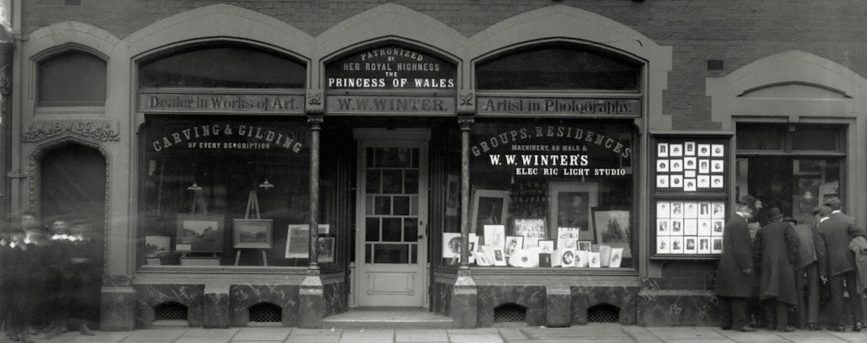This weeks blog describes the studio as a hub for art of all types!
More from the newspapers: Winter the Artist
Walter Winter styled himself as an artist in photography. One only has to look at the hand coloured photographic portraits he produced to realise that he was extremely skilled in this field. Walter Winter came from a line of East Anglian artists. His grandfather John Winter was an artist and painter of glass and his father Cornelius and brother Holmes both worked as artists. One wonders what might have been if Walter hadn’t turned to photography.
The 1861 Census has Walter living in Great Yarmouth with his father and described as an ornamental painter. Cornelius is described as an artist and painter of animals and portraits. He is known to have been a photographer being described as such in White’s Directory of Norfolk for 1854. This was not unusual, many artists turned to photography, and early directories listed artist and photographers under the same heading before separating the two in the late 1860s. Walter and his father retained close links when he moved to Derby. From correspondence we know Cornelius visited the town and they passed work to and from each other – photographs for finishing and works of art for sale. The transactions are listed in a small notebook found at the Winter’s premises.
Newspaper articles reveal that Walter dealt in fine art and antiquities, particularly china, holding sales at auction rooms in Derby and Leicester. The business had its own fine art department, and after the premises were remodelled following the fire an annual art exhibitions. Newspapers reported the event and described the exhibits. As well as the traditional oil and watercolour, there were paintings on silvered glass, china and terracotta. Needlework was also a feature. Exhibitors numbering up to 350 professional and amateur artists came from the UK and abroad. Prizes and medals were awarded. A recently discovered print shows the medal awarded in 1892 to an Ada Parnham. One wonders if readers know of any other medals still in existence – if so Winter’s would be delighted to hear about them! The Fine Art Department came to an end in 1896 when Walter Winter announced its closure and the sale of many items. The space was needed to provide a showroom for specimens of Art Photographic Portraiture.
Walter Winter’s early training as an artist is reflected in the superb quality of his photography which came to be acknowledged in the UK and abroad by the number of medals he won. He was as he advertised…..an artist in photography.
